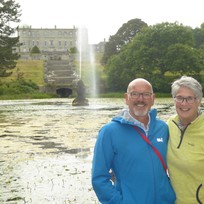( Overview
/ Two Scilly Bullocks on a Boat
Scilly is amazing, a beautiful archipelago, but we’ve also had a ‘swell’ time. Different bays have protection from the varying wind directions, but it’s almost impossible to escape the Atlantic swell. Sleeping with earplugs and ‘blocking’ the persistent noise and movement is not a talent we possess.
The swell is tide dependent, and does reduce as the tide recedes, so we must have slept a little in the early hours, as when we awoke, the other 4 boats in the cove had already set off for France, and we hadn’t heard a thing!
The 2nd lighthouse to be built in the western approaches (in 1680) after Lizard Point. 74 feet tall, it also had gun ports. Built on St Agnes’ highest point as the most westerly of the habitable islands, it was prone to fog and decommissioned in 1911 when superseded by Peninnis lighthouse.
Trying to capture the dolphins that joined us regularly on our journey, playing in our bow wave and diving under the boat. In the end we just enjoyed their company.
This time, we think they were Common, or Short-beaked Common Dolphins. They grow to up to 2.7 metres and weigh 150kg with a lifespan of up to 35 years. At sea they can form supergroups made up of thousands of individuals, and can reach speeds of around 30 miles per hour. We only saw a few at a time!
DFDS Ro-Ro ferry passing Bishop Rock Lighthouse. Coming from Ireland and heading to the Netherlands.
Bishop Rock Lighthouse was built by Trinity House in 1858—and further strengthened in 1887—to mark a rock ledge 46m long by 16m wide, four miles west of the Isles of Scilly.
The rocks around the Isles of Scilly wrecked many ships over the years, including the loss of Sir Cloudesley Shovel's squadron of the British Fleet in 1707 in which 2,000 men died. St Agnes lighthouse was considered inadequate so a 74m lighthouse was planned on the most westerly danger, Bishop Rock.
A very pristine-looking fishing vessel. Lots of shipping activity, fishing boats and some yachts. We also soon spied Land’s End in the distance. Having not had 4g in The Cove, amazingly we could pick it up most of the way over!
Lizard Point is the most southerly point on mainland Great Britain. The first sighting of the Spanish Armada on mainland Britain was here in 1588.
Lizard Lighthouse, the first western lighthouse, was initially built in 1619. 62 feet tall, it can be seen 100 miles away on a good day.
Pilgrim of Brixham is now used for cruises out of Falmouth, often to Scilly. Probably heading to port early because the forecast gale. The winds were so light we couldn’t sail, but because of its sail configuration, BM45 was able to tack very slowly down wind.
As we entered the Helford River, there was another securite message on channel 16 (our first had been on our passage from Ireland). Once again this was warning of an impending gale, so this time we were thankful to be tied up to a sturdy looking mooring buoy.
Although we experienced the Atlantic rollers once again on our 9 hour crossing, the waves were less high, the wind lighter and the sun shone.



























 Sign in with Apple
Sign in with Apple  Log in with Facebook
Log in with Facebook